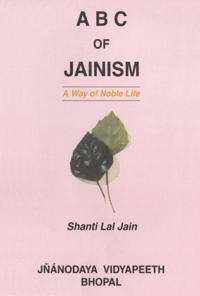LESSON 11
Bhagavāna Mahāvīra
Place of birth | Kundagrāma (Vaiśālī) |
Name of Father | King Siddhartha |
Name of Mother | Gueen Trisalā (Priyakārinī) |
Emblem (Chinha) | Lion |
Body colour | Golden |
Period of Prince-hood | 30 years |
Marital Status | Unmarried |
Date of birth | Caitra Śukla 13, 599 B.C |
Date of monk-hood | Magasira Śukla 10; 569 B.C |
Date of attaining perfect knowledge (kevala Jñāna) | Valsākha Śukla 10; 557 B.C. |
Date of Salvation (nirvāṇa) | Kartika Kṛṣṇa 30; 527 B.C. |
Place of Salvation (nirvāṇa bhūmi) | Pāvāpura, India (Bharata-Kṣetra) |
Total Age | 72 years |
Bhagavāna Mahāvīra was twenty-fourth and last Tīrthankara. He was born in Kundagrāma. His father, Sidhāratha was the King of Vaisali-Janpada. His mother Trisalā was the pious daughter of King Cetaka. His mother was also known as Priyakārinī,
At the time of conception, mother Trisala had sixteen meaningful and beautiful dreams. She was much elated and happy. Next morning, she asked King Siddhāratha about the dreams. He said that she was going to have an extraordinary child, who will preach the path to salvation for all.
With the birth of Mahāvīra, prosperity increased; so King Siddharatha called his son Vardhamana. Once upon a day, simply by seeing Vardhamana, the philosophical doubt, of Sanjaya and Vijaya Munīs was resolved; so, he was given the name "Sanmati" by the Munīs.
He once, controlled and pacified an amuck elephant, therefore the people of Vaisalī addressed him as 'Vīra'. Vardhamana in his childhood was very brave. He had extra ordinary physical and spiritual power. Once upon a day, Sangamdeva, a celestial being came to test the bravery of Vardhamana. Sangamadeva assumed form of a cobra. Vardhamana fearlessly played with it. So, Sangamadeva bestowed on him an honor of 'Mahāvīra'.
Gradually, Mahāvīra attained adulthood, but worldly pleasures did not attract him, His parents desired to marry him with a beauful Princess Yasoda. Despite this, Mahāvīra exhibited non-attachment to mundane desires.
Mahāvīra saw that life's pain and suffering are rooted in attachment, likes and dislikes. So, he refused to marry and left his princely comforts. This is known as 'Mahā-Abhiniskramana'-that is the Great Renunciation of Mahāvīra, at the age of thirty. From that time, Mahāvīra moved as Nirgrantha-Munī i.e. a naked ascetic.
He endured with the greatest equanimity, all sorts of abuses and tortures inflicted on him by vicious persons. Mahāvīra meditated day and night undisturbed and unperturbed. At last, under the Śālā tree on the bank of the river Rjukūlā, outside the town Jṛmbhika, he attained supreme knowledge known as Kevala-Jñāna and became Arihanta at the age of forty two years.
After the attainment of Kevala-Jñāna, Mahāvīra remained silent and did not deliver any sermon for sixty six days, in the absence of Gaṇadhāra. Gaṇadhāra is the only person who is capable and authorized to translate, pronounce and lay down the wordless preachings of Tīrthankara in languages for the benefit of all time to come.
One day, Mahāvīra arrived at Vipilācala mountain outside the city of Rājagraha (India), where Samavasarana (religious assembly) was organized. As a result of the presence of a renowned Brahmin scholar named Indrabhūti-Gautama in the assembly, Mahāvīra delivered his first sermon at the Vipulācala mountain. This day is celebrated as the "Vira-Śāsana-day" by Jainas. Indrabhūti-Gautama was designated as the first Gaṇadhāra (chief-disciple) of Mahāvīra.
For full thirty years, Mahāvīra travelled different parts of the country (India) and preached the doctrine of Ahimsa and Anekānta. Owing to the magnetic personality of Bhagavāna Mahāvīra and his powerful ethical and spiritual teachings, number of kings, queens, princes, princesses, ministers and merchants accepted him as their teacher. The males and females of all castes and classes became the ardent followers of Mahāvīra and thus his fourfold order of Munī (male ascetics), Āryikā (female ascetics), Śravakas (male householders) and Śrāvikās (female householders) came into existence.
Candanabātā became a most prominent Āryikā and King Śrenika became a main Śrāvakā amongst Bhagavāna Mahāvīra's followers.
Bhagavāna Mahāvīra attained Nirvāṇa at Pāvāpura in the state of Bihar in India, at the age of seventy two years, in 527 B.C. It was early morning of Kartika Kṛṣṇa Triyodasi. On the same evening, Gautam Gaṇadhara attained the Supreme Knowledge or Kevala-Jñāna. This day is being celebrated as the Dīpāvalī-festival (festival of lights) all over India. We Jainas worship the event by offering sweets (Lad us) before the idol of Tīrthankara Mahāvīra in early morning and also celebrate as the festival of lights, at night.
 Shanti Lal Jain
Shanti Lal Jain
